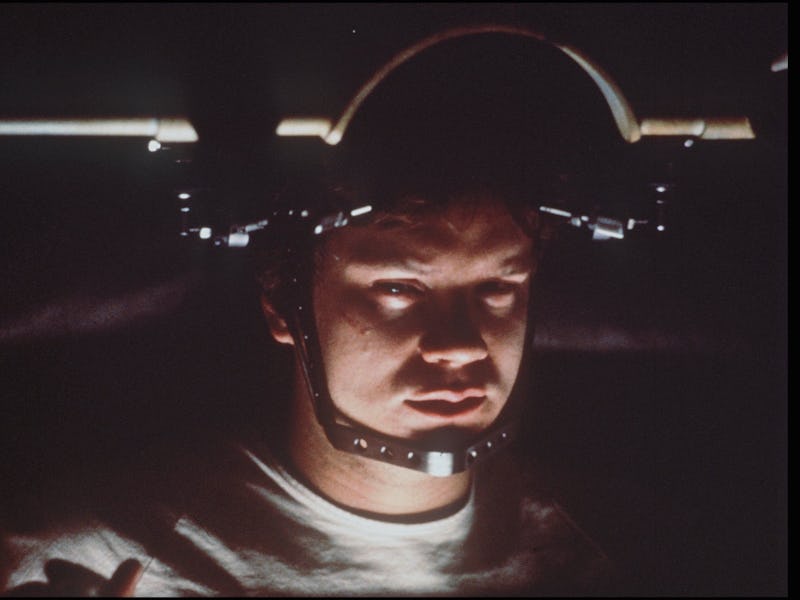One of the Most Influential Horror Movies Ever Made Is Getting The 4K Treatment
A new 4K restoration of Jacob’s Ladder renders the nightmarish reality even more vividly.

Screenwriter Bruce Joel Rubin once dreamt that he’d gotten off a train and ended up trapped in a subway station with no exits. The only way out was “through the dark tunnel…into some kind of awful hell.” Out of his nightmarish vision emerged Jacob’s Ladder (1990), a tragic, terrifying portrait of a mind on the edge and what pushed it there. Similar unsettling imagery haunts its protagonist Jacob Singer (played with a boyish sweetness by Tim Robbins), a Vietnam war veteran not only grappling with violent flashbacks of his military service, but also the grief of losing his youngest son.
As the film progresses, he’s plagued by paranoia and hallucinations, the world of the film growing increasingly disorienting and oppressive as it mirrors his fragmented mental state. Demonic creatures torment Jacob, who begins suspecting he’s part of a government conspiracy and coverup. An outlier in director Adrian Lyne’s filmography of erotic thrillers such as Fatal Attraction (1987) and Indecent Proposal (1993), the bodies in Jacob’s Ladder are instead grotesque, even unnervingly inhuman.
A new 4K restoration promises a vivid tour of Jacob’s hellish mindscapes.
HOW WAS JACOB’S LADDER RECEIVED UPON RELEASE?
Waiting outside a theatre in Westwood, California, hoping to hear audience’s reactions during the film’s opening weekend, Rubin saw an irate moviegoer run out and yell, “If I ever meet the guy who wrote that movie, I’ll kill him!'” Not a great sign. Though the writer had pitched Jacob’s Ladder as a serious “art film,” the studio marketed it as a traditional horror movie, which he came to believe hurt its commercial prospects. While it did debut at No. 1 in the US, it was toppled by supernatural slasher Child’s Play 2 only a week later, ultimately grossing just $26.1 million against a $25 million budget.
Lyne too knew he hadn’t made a commercial film, but a puzzle that required repeat viewings to piece together — a potential problem.
He had cut out a full fifth of Jacob’s Ladder for brevity, including a scene in which his protagonist is threatened by a bloody, tentacled demon descending from the ceiling. Even so, its relentless bleakness proved too much for some viewers. Entertainment Weekly’s Owen Gleiberman called it “two hours of anything-for-a-shock unpleasantness.” Roger Ebert was more complimentary, describing it as a “thoroughly painful and depressing experience — but, it must be said, one that has been powerfully written, directed and acted.”
The devastation wrought by its twist lingered, however, and over the years, the film gained a cult following.
WHY IS IT IMPORTANT TO SEE NOW?
Tim Robbins’ Jacob is plagued by hallucinations that grow increasingly demonic.
For a film about heaven, hell and the terrors of languishing in purgatory, it’s only fitting that Jacob’s Ladder went on to have a rich cultural afterlife of its own, shaping the visual language of horror movies and video games decades on. The film slips disconcertingly between the past and present, reality, dream, and vivid nightmare, and ordinary environments abruptly plagued by feverish hallucinations. Filmmaker Christopher Nolan pointed to its editing rhythms — in which “you’re seeing things, but it’s so quick, you don’t know what you’re seeing” — as an influence on his Oscar-winning biopic Oppenheimer (2023). Consider the scene in which the titular physicist (Cillian Murphy), giving a victory speech following the Hiroshima and Nagasaki bombings, is stricken by haunting visions of a nuclear flash enveloping the crowd and a young woman’s face peeling off in the aftermath.
Jacob’s Ladder is also one of filmmaker Darren Aronofsky’s favourite movies, as he mentions in the Requiem for a Dream (2000) audio commentary. Both films share an actress — Suzanne Shepherd — but also a pervasive atmospheric unease. A sequence in which an injured Jacob is pushed along hospital corridors on a gurney unfolds like a descent into the bowels of hell itself, his pained disorientation reflected by Requiem’s elderly widow (Ellen Burstyn) as she’s hospitalized and subjected to electroconvulsive therapy. Like Jacob’s Ladder, Aronofsky’s debut Pi (1998) also follows a mentally fragile man (Sean Gullette) who finds himself at the centre of a conspiracy. And like Jacob’s Ladder, his psychological horror film Black Swan (2010) features disquieting bodily transformations.
Japanese survival horror game series Silent Hill draws heavily on imagery from the film — which art director and monster designer Masahiro Ito called the “first movie that ever scared him” — but also finds thematic resonance by making its physical settings in the first installment a manifestation of the protagonist’s psychological distress.
Likewise, a musical number in American Horror Story: Asylum plays out as a patient’s shock therapy-induced fantasy — “in her head and as the beginning of her descent [into madness],” said creator Ryan Murphy, citing Jacob’s Ladder as the inspiration.
You can spot the film’s violent demonic head shake — a fast-twitching effect achieved by having an actor move his head slowly at a low frame rate, producing a blur when played back at normal speed — in movies ranging from the supernatural horror film House on Haunted Hill (1999) to Austrian psychological thriller Goodnight Mommy (2014) to even superhero blockbuster Avengers: Infinity War (2018).
WHAT NEW FEATURES DOES THE BLU-RAY HAVE?
At first released to a tepid reception, film has since recieved cult classic status.
With the 4K color grading and restoration of the film supervised by Lyne himself, the Blu-ray includes On The Rungs Of Jacob’s Ladder, a documentary by French film journalist Didier Allouch with interviews featuring the director, Robbins, and Rubin.